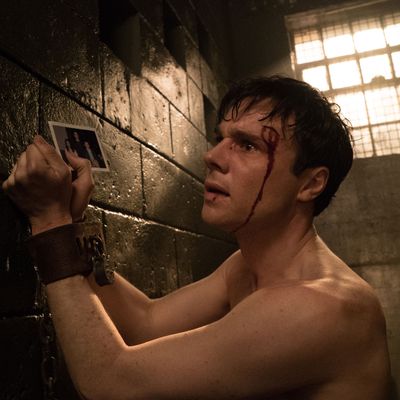
Despite the arrival of new menacing villain, played by Torchwood’s Burn Gorman, the third episode of Amazon’s The Man in the High Castle is a bit of a letdown after the tense pace of first two chapters. It’s still good television, especially when compared to other Amazon shows like Bosch and Hand of God, but there’s reason to worry about the pacing here. The characters are beginning to feel stuck in a narrative rut.
As The Man in the High Castle has done before, “The Illustrated” picks up immediately after the end of the last episode. Juliana (Alexa Davalos) had to push Origami Man (formerly referred to as Bible Man in these recaps, but the characters started using this name, so we’ll comply) off the dam, and she’s rattled by his death. Joe (Luke Kleintank) tries to comfort her, telling her how he once had to kill somebody too. Typical guy, making it all about him. Then, he warns her of something I hadn’t considered: what if there no contact in Canon City? What if Trudy was walking into Origami Man’s trap? The next morning, after Juliana realizes that she left Frank’s drawing on the bridge, Joe urges her to skip town with him. They can’t leave together, though. That would look suspicious. Joe decides to wait outside of town, while she finishes her shift at the Sunrise Diner.
In San Francisco, Frank (Rupert Evans) comes home battered, bruised, and devastated. Understandably, he’s been traumatized. When Ed (DJ Qualls) checks in on him, he finds something on his step. Is it a death notice? Frank has to identify his sister and her children before their bodies are cremated. Frank smokes and, while he’s talking with Ed, they notice a report about the Crown Prince of Japan’s visit to town. Frank says he isn’t going back to work. Clearly, this is the arc of a man thrown into his destiny by tragedy. A Resistance member is being born.
Meanwhile, Joe calls Smith (Rufus Sewell) with a progress report. Smith wants his agent to return home, but Joe wants to wait for the contact — and protect Juliana. Will his growing affection for her derail his mission? At the same time, Juliana finally reaches Frank by phone. They don’t say much. How could they? How could he possibly tell her the horror of what’s happened? She hears the pain in his voice, but she can’t bring herself to tell him that she killed a man. They must keep their tragedies secret, for now.
As Joe gets gas, up pulls the Marshal (Burn Gorman), a man referenced in the first episode as the only law in this lawless land. He wears a cowboy hat and a duster, looking and talking like Clint Eastwood’s “Man with No Name.” (He even speaks through gritted teeth clamped on a toothpick.) He asks Joe for his papers, then pulls out a shotgun; he’s looking for Origami Man. The Marshal is a dirty, dangerous bounty hunter, a fascinating third villain who balances out the rigid, disciplined malevolence of Smith and Kido (Joel de la Fuente).
Joe returns to Canon City to warn Juliana, while the Marshal goes to the book store to look for his contact. The bookseller tells him that Origami Man bought a Bible, then a girl followed and did the same. He’s now on Juliana’s trail. In the terrifying scene that follows, the Marshal reveals that he knows the bookseller is using a false identity. He’s really an escaped prisoner named David P. Frees. “I’m going to kill you now,” he tells him. “There’s nothing you can say or do about that, but I’m gonna need something first.” He strings up the man on Main Street, like a lynch victim. The director, Ken Olin, is clearly referencing the racial terrorism of the South that vile bigots used to strike fear into black communities. (The use of Billie Holiday’s “Strange Fruit” in the second episode doesn’t seem coincidental, either.)
Frank’s brother-in-law comes home to find Frank sitting on his front step. Frank has to tell him that his entire family is dead. As Frank’s pain becomes more palpable, he seems to be on an inevitable path toward violence. Later, Frank’s brother-in-law wishes tragedy upon him; he says that he hopes he has kids, so they can be taken away from him.
In New York, Smith and his lackeys interrogate the survivor of last episode’s ambush. He’s been given a drug that makes him essentially useless, though; hallucinogens and interrogations don’t mix well. We even get a point-of-view shot that shows the subject’s hazy consciousness as he says, “You have a halo.” Sewell is great in this scene—frustrated, but still purposeful and commanding. The interrogation will have to wait until the “oceanic experience” wears off. After it does, Smith plays a sadistic game with one of his soldiers. He tells him that the ambush leader named him as a conspirator. There doesn’t seem to be much reason to believe it, and we didn’t hear the accusation. Smith is a master of control, scaring his soldier into confessing if there’s anything at all to confess — and this time, there isn’t. The mole’s identity is still unknown.
Back on the West Coast, Frank is drinking at a bar. Who could blame him? He meets someone who knows about the horror he’s been through. His story has already filtered through the underground to the Resistance. He’s being recruited. He doesn’t want to give in, still fighting his fate. He blames the movement. It’s too late, though. He’s involved and there’s nothing he can do to stop it.
The Nazis request that the Crown Prince cancel his public appearance. They’re worried about the growing Resistance. Or are they? The Crown Prince wants to speak. Could something go wrong? They certainly foreshadow a bad outcome, but Kido thinks that the Nazis are just trying to destabilize the Japanese regime. If they blame the Resistance, they take away the leader’s chance to inspire his people.
After seeing another report about the Crown Prince, Frank goes back to work at Chekhov’s gun factory. It’s not long before Frank begins to building a real gun instead of a replica. A worried Ed notices.
The Marshal goes to the dam where Origami Man died, and finds the sketch of Juliana. The lesson here is clear: Never draw your loved ones, unless you want insane bounty hunters to find them. (Art kills, people!) Meanwhile, after they’ve disposed of Origami Man’s body, Juliana tries to convince Joe that the world can change. They have an interesting but overly scripted conversation about fate. (“Maybe if I’d met you sooner my life would be a whole lot different.”) Of course, Joe’s life is about to be a whole lot different anyway. Is he the reluctant Nazi saved by love? I’m starting to worry his arc will be too predictable. He needs something to do, rather than just saving Juliana and following orders from Smith.
They find a dead, tortured woman in Origami Man’s secret horror hovel. He was eliminating Resistance members, one by one, and had a list with two names that weren’t crossed off: Trudy Walker and Lemuel Washington, Juliana’s boss at the Sunrise Diner. Cut to the Marshal and Washington at the diner, where the bounty hunter shows him the drawing of Juliana. She used to work here, he says, but she’s gone. Joe and Juliana come back to town, see the bookseller hanging on Main Street, then the Marshal starts shooting at them. Juliana runs down an alley and through a door, chased by a shotgun-toting Marshal. Talk about a cliffhanger. How could you not watch the next episode?
Other Notes
- My God, that opening cover version of “Edelweiss” is creepy. Can you imagine the producer’s notes? “Do it scarier! Imagine the girls in The Shining singing a song! Whisper-sing it! Give me nightmares!”
- Not only did Ken Olin once star in Thirtysomething, he’s been a resilient TV director for decades — he’s worked on The West Wing, Alias, and Brothers & Sisters — and he does a solid job here, despite the wheel-spinning nature of the plotting.
- Two good music cues this week: “Summertime” by Billie Holiday, when Juliana and Joe get rid of the Origami Man’s body — “The living is easy,” indeed — and “It’s Nobody’s Fault But Mine” by Sister Rosetta Thorp, as Marshal questions Lem. Both cues cut across scenes in different parts of the country, holding the various plot threads together. Olin uses them well.
- Burn Gorman! If you’re not familiar with his work, watch Torchwood. It’s great.
- Speaking of Gorman, his gritted-teeth delivery is so reminiscent of Eastwood in Sergio Leone’s films. A Fistful of Dollars came out two years later than The Man in the High Castle’s 1962 setting, and I think it’s a conscious influence. Leone’s films are a unique cultural integration, a European view of the West. That type of blending would be prevalent in the High Castle society of American, German and Japanese cultures.
- The Marshal has a deck of playing cards of his most-wanted bounties. This is yet another reference to current conflicts; everyone knows playing cards were prominently used for Saddam Hussein and his cronies. Though some reports suggest the technique dates to the Civil War, it’s one of many ways that the High Castle writers call back to contemporary issues within their alternate history.


